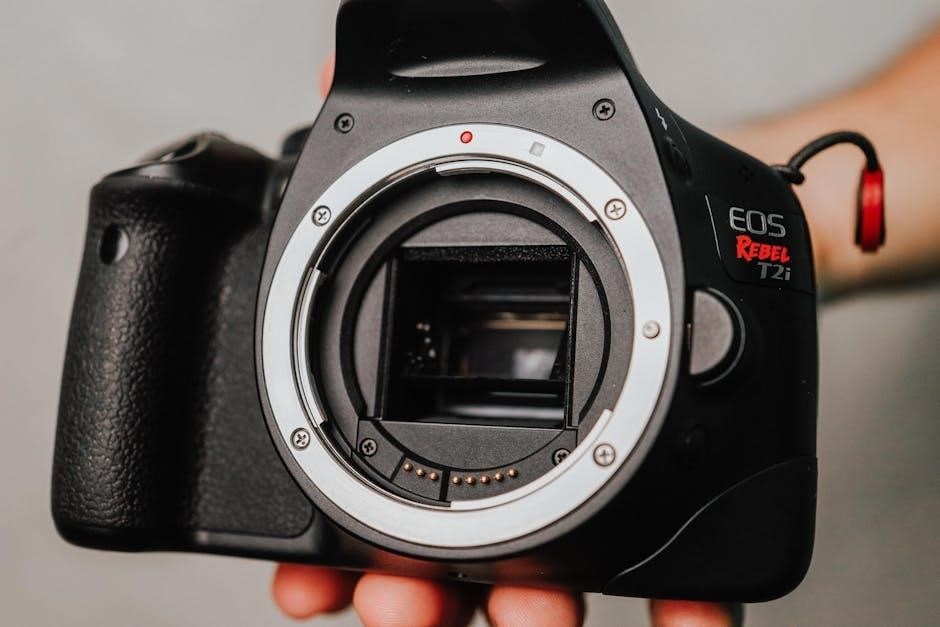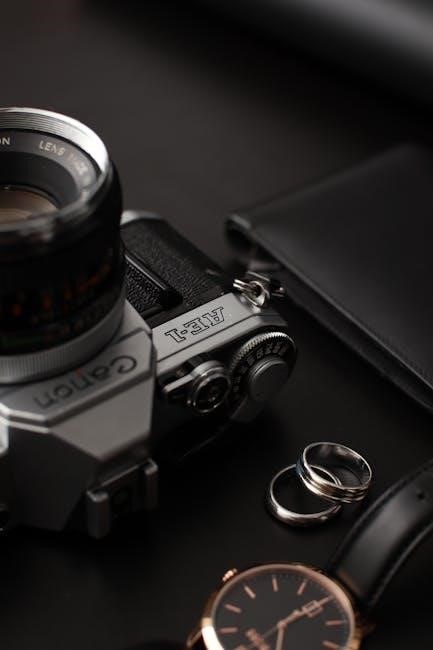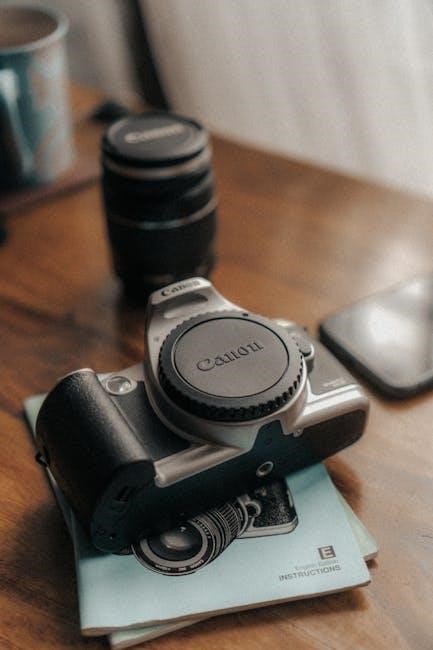The Canon EOS Rebel T3 is a 12.2-megapixel DSLR camera featuring a CMOS sensor and DIGIC 4 image processor, designed for photographers of all skill levels.
Overview of the Canon EOS Rebel T3
The Canon EOS Rebel T3 is a high-performance DSLR camera designed for photographers seeking quality and ease of use. With a 12.2-megapixel CMOS sensor and DIGIC 4 image processor, it delivers crisp images and excellent color accuracy. The camera features a 2.7-inch LCD monitor, HD video recording, and compatibility with EF-S lenses. Its intuitive interface and creative shooting modes make it ideal for both beginners and advanced users, offering flexibility and control for capturing stunning photos and videos.
Key Features and Specifications
The Canon EOS Rebel T3 features a 12.2-megapixel CMOS sensor and DIGIC 4 image processor, ensuring high-quality images with vibrant colors. It supports HD video recording at 720p and offers an ISO range of 100-6400 for versatile shooting. The camera includes a 2.7-inch LCD monitor, optical viewfinder, and compatibility with EF-S lenses. With continuous shooting up to 3fps, SD/SDHC/SDXC card support, and a lightweight design, the Rebel T3 is a versatile tool for photographers, combining ease of use with advanced manual controls and scene modes.

Getting Started with the Canon Rebel T3
Unbox and familiarize yourself with the Rebel T3, including the camera body, lens, battery, and charger. Follow the manual for initial setup and configuration.
Unboxing and Essential Accessories
Inside the box, you’ll find the Canon Rebel T3 camera body, an EF-S 18-55mm IS II lens, a battery pack LP-E10, battery charger LC-E10, neck strap, and lens cap.
- The camera body is lightweight and ergonomically designed for comfort.
- The 18-55mm lens is ideal for everyday shooting, featuring image stabilization.
- The battery and charger ensure extended shooting sessions.
- The neck strap provides convenient carrying.
- The lens cap protects the lens from dust and scratches.
Additional accessories like a memory card and external flash are recommended for enhanced functionality.
Initial Setup and Camera Configuration
Start by charging the LP-E10 battery and inserting it into the camera. Install a memory card to store your photos and videos. Attach the EF-S 18-55mm IS II lens, ensuring it clicks securely into place. Turn on the camera and navigate to the menu to set the date, time, and language. Choose your shooting mode and enable Auto Playback for image review. Refer to the manual for detailed steps on configuring additional settings like autofocus and metering modes.
Understanding the Camera Modes
The Canon Rebel T3 offers various shooting modes, including Auto, Manual, Aperture Priority, and Shutter Priority, catering to both beginners and advanced photographers. These modes provide flexibility in controlling exposure settings, enabling users to capture images tailored to their creative vision. The camera’s intuitive design makes it easy to switch between modes, ensuring optimal results in different lighting conditions and photography scenarios. This feature-rich system allows photographers to grow their skills while maintaining creative control. The modes are clearly explained in the instruction manual, helping users master their functionality. The Rebel T3’s versatility makes it a great tool for learning and refining photography techniques. Its user-friendly interface ensures that even novice photographers can achieve professional-quality images by understanding and utilizing the available modes effectively. The camera’s advanced modes, such as Manual, give precise control over aperture, shutter speed, and ISO, allowing for customized shots. Meanwhile, Auto mode simplifies the process for those who prefer point-and-shoot convenience. The Rebel T3’s range of modes ensures that photographers of all levels can produce stunning images with ease and confidence.
Auto Mode for Beginners
Auto Mode on the Canon Rebel T3 simplifies photography by automatically adjusting settings like aperture, shutter speed, and ISO for optimal results. Designed for beginners, it eliminates the need for manual adjustments, allowing users to focus on composition and capture moments effortlessly; The camera analyzes lighting conditions and selects the best settings, ensuring well-balanced images. This mode is ideal for those new to DSLR photography, providing a user-friendly experience while delivering high-quality photos. It’s perfect for everyday shooting, letting the camera handle the technical details. With Auto Mode, capturing stunning images is quick and straightforward.
Manual Mode for Advanced Control
Manual Mode on the Canon Rebel T3 offers advanced photographers full creative control by allowing manual adjustments to aperture, shutter speed, and ISO. This mode is ideal for those who want precise control over their shots, enabling customization to achieve specific artistic effects. With Manual Mode, photographers can experiment with lighting, depth of field, and motion blur, tailoring each setting to their vision. It provides the flexibility to fine-tune every aspect of the image, making it a powerful tool for capturing unique and professional-quality photos.

Using the LCD Monitor and Live View
The Canon Rebel T3 features a 2.7-inch LCD monitor with 230,000 dots for previewing shots and accessing settings. Live View mode enables precise focus and framing using the LCD screen, making it ideal for creative control and accurate composition.
Navigating the LCD Screen
The Canon Rebel T3’s 2.7-inch LCD screen displays shooting information, menu options, and image playback. Icons represent settings like aperture, shutter speed, and ISO. Use the cross keys to navigate menus and adjust settings. The Quick Control button provides direct access to common functions. During image playback, use the zoom button to enlarge details and the erase button to delete unwanted photos. This intuitive interface allows for efficient adjustments and quick review of your work, enhancing your overall shooting experience.
Live View Shooting and Focusing
Live View on the Canon Rebel T3 allows for composition using the LCD screen. Press the SET button to activate Live View mode. Focus modes include Quick AF, Live AF, and Face Detection AF. Face Detection AF automatically detects and tracks faces, adjusting focus and exposure. Use the cross keys to manually select focus points. The LCD provides real-time preview of settings, enabling precise adjustments. This feature is ideal for creative control and accurate focusing, making it easier to achieve sharp, well-framed images in various shooting scenarios.
Focusing and Metering
The Canon Rebel T3 features a 9-point autofocus system for precise subject tracking. Metering modes include evaluative, center-weighted, and spot metering for accurate exposure control in various lighting conditions.
Autofocus Modes and Settings
The Canon Rebel T3 offers multiple autofocus modes, including One-Shot AF for stationary subjects and AI Servo AF for moving objects. Users can select from 9 AF points or use AI Focus AF for automatic switching. Settings can be customized to enhance focusing accuracy, such as adjusting AF point selection or enabling AF-assist beam. These features ensure sharp images in various shooting scenarios, catering to both beginners and advanced photographers.
Manual Focusing Techniques
Manual focusing on the Canon Rebel T3 allows precise control over focus. Switch to MF mode and adjust the lens focus ring to achieve sharpness. Use the viewfinder or LCD for accurate framing. For still subjects, center the focus ring on the desired point. For moving subjects, pre-focus on the expected position. Utilize the DOF preview button to check depth of field. In Live View, zoom in on the subject for critical focus accuracy. This method is ideal for creative control and macro photography.
Shooting Movies with the Canon Rebel T3
The Canon Rebel T3 allows HD video recording up to 720p. Use the mode dial to select Movie mode. Adjust settings via the menu for resolution and frame rate. Press the Live View button to start and stop recording. Utilize the LCD screen for monitoring. Focus manually or use autofocus for smooth transitions. Stabilized lenses enhance video quality. Record clips up to 4GB or 29 minutes and 59 seconds. Transfer videos via HDMI for playback on external devices.
Video Recording Basics
To begin recording video on the Canon Rebel T3, switch to Movie mode using the mode dial. Press the Live View button to start and stop recording. Use the LCD monitor to preview your footage. Choose from HD (720p) or SD (VGA) resolutions. Frame rates are 30 or 25 fps. Set focusing using AF before recording or switch to MF for manual control. Ensure a Class 4 or higher SD card is inserted for smooth recording. Videos are saved in MOV format with mono audio. External microphones can enhance sound quality. The camera limits recording to 4GB or 29 minutes and 59 seconds to prevent file size issues. Stabilized lenses reduce camera shake during recording. Playback videos on the LCD or connect via HDMI to external devices for better viewing. Always clean the sensor and lens before filming to avoid dust spots. Familiarize yourself with menu settings to optimize video quality and settings. Refer to the manual for advanced configurations and troubleshooting tips. This ensures high-quality video capture tailored to your creative needs.
Advanced Video Settings and Tips
For advanced video recording, the Canon Rebel T3 offers manual exposure control, allowing adjustment of aperture, shutter speed, and ISO. Enable Manual mode (M) on the mode dial for precise control. Use the Q Menu to access settings like white balance, Picture Style, and AF modes. External microphones can be connected for higher audio quality. Stabilized lenses reduce camera shake during handheld filming. Shoot in HD (1280×720) for cinematic quality. Adjust frame rates to 30 or 25 fps. Use a Class 4 or higher SD card for smooth recording. Videos are saved in MOV format with mono audio. External microphones enhance sound. The camera limits recording to 4GB or 29:59. Clean the sensor and lens before filming. Familiarize yourself with menu settings for optimal results. Refer to the manual for advanced configurations. This ensures professional-grade video capture tailored to your needs.

Image Playback and Editing
The Canon Rebel T3 allows easy image review with zoom, rotation, and slide show features. Basic editing tools enable resizing, cropping, and protecting or erasing images directly on the camera.
Reviewing and Managing Photos
The Canon Rebel T3 offers convenient photo review options. Users can rotate images, play slide shows, and protect or erase photos directly on the camera. The LCD monitor provides clear image playback, allowing for easy navigation and organization; Shooters can also assign ratings to photos for quick sorting. Basic editing features like resizing and cropping are available, making it simple to manage and enhance images without transferring to a computer. This user-friendly system ensures efficient photo management for photographers of all levels.
Basic In-Camera Editing Features
The Canon Rebel T3 offers basic in-camera editing tools, allowing users to enhance photos without a computer. Features include resizing images, cropping to focus on key subjects, and correcting red-eye caused by flash. The camera also enables brightness and contrast adjustments for fine-tuning image quality. These editing options are accessed through the LCD monitor, providing a user-friendly interface for quick modifications. This built-in editing capability helps maintain image integrity while offering convenience for photographers seeking to refine their shots on the go.

Maintenance and Troubleshooting
Regularly clean the sensor and lens to ensure optimal performance. Check for firmware updates and refer to the manual for troubleshooting common issues and solutions.
Cleaning the Sensor and Lens
Regular cleaning of the sensor and lens is essential for maintaining image quality. Use a soft, dry microfiber cloth to wipe the lens and camera’s exterior. For the sensor, enable Manual Cleaning via the menu, then use a blower or brush to gently remove dust. Avoid touching the sensor surface. If smudges persist, consult the manual for detailed cleaning steps or consider professional service to ensure optimal performance and prevent damage to your camera.
Common Issues and Solutions
Common issues with the Canon Rebel T3 include sensor dust, battery drain, and memory card errors. For sensor dust, use the camera’s self-cleaning mode or manual cleaning tools. Battery life can be extended by turning off unused features like GPS. Memory card errors often require formatting the card in-camera. If problems persist, refer to the manual or Canon support for firmware updates and troubleshooting guides to ensure optimal performance and resolve technical difficulties effectively.



